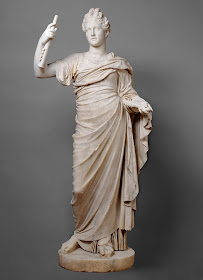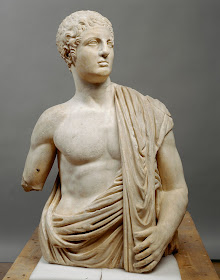 |
| Ignaz Elhafen Diana and her Nymphs ca. 1695 ivory relief Kunsthistorisches Museum, Vienna |
 |
| Ignaz Bendl Apollo and Diana slaying the Children of Niobe 1684 ivory relief Kunsthistorisches Museum, Vienna |
 |
| Christoph Maucher Hercules battling the Hydra (fragments from the throne of Emperor Leopold I) 1677 amber relief-plaques Kunsthistorisches Museum, Vienna |
 |
| Daniel Neuberger Neptune ca. 1666 wax relief on agate Kunsthistorisches Museum, Vienna |
Sonnet VII
Whither is gone the wisdom and the power
That ancient sages scattered with the notes
Of thought-suggesting lyres? The music floats
In the void air; e'en at this breathing hour,
In every cell and every blooming bower
The sweetness of old lays is hovering still:
But the strong soul, the self-constraining will,
The rugged root that bare the winsome flower
Is weak and withered. Were we like the Fays
That sweetly nestle in the fox-glove bells,
Or lurk and murmur in the rose-lipped shells
Which Neptune to the earth for quit-rent pays,
Then might our pretty modern Philomels
Sustain our spirits with their roundelays.
– Hartley Coleridge (1833)
 |
| Gérard van Opstal Putti playing with a Goat ca. 1650-65 ivory relief Kunsthistorisches Museum, Vienna |
 |
| Georg Schweigger Sleeping Diana 1650 limestone relief Kunsthistorisches Museum, Vienna |
 |
| Ottavio Miseroni Ceres ca. 1602-1605 cameo in commesso relief (agate, jasper, chalcedony, with enameled-gold mount) Kunsthistorisches Museum, Vienna |
 |
| Hendrik Goltzius Bacchus, Venus, Ceres and Cupid 1595 silver printing plate Kunsthistorisches Museum, Vienna |
 |
| Antonio Abondio Toilette of Venus ca. 1587 bronze plaquette Kunsthistorisches Museum, Vienna |
 |
| Giovanni Maria Mosca Artemis, Protectress of Wild Animals ca. 1525 bronze plaquette Kunsthistorisches Museum, Vienna |
 |
| Hans Daucher Judgment of Paris 1522 limestone relief Kunsthistorisches Museum, Vienna |
 |
| Galeazzo Mondella (called Moderno) Hercules and the Nemean Lion ca. 1488-89 bronze plaquette Kunsthistorisches Museum, Vienna |
 |
| Roman Empire Abduction of Persephone 3rd century AD marble sarcophagus Kunsthistorisches Museum, Vienna |
 |
| Roman Empire Apollo at the Omphalos 2nd century AD marble relief Kunsthistorisches Museum, Vienna |









































